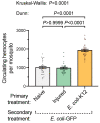Adult Mosquitoes Infected with Bacteria Early in Life Have Stronger Antimicrobial Responses and More Hemocytes after Reinfection Later in Life
- PMID: 32481519
- PMCID: PMC7349202
- DOI: 10.3390/insects11060331
Adult Mosquitoes Infected with Bacteria Early in Life Have Stronger Antimicrobial Responses and More Hemocytes after Reinfection Later in Life
Abstract
The immunological strategies employed by insects to overcome infection vary with the type of infection and may change with experience. We investigated how a bacterial infection in the hemocoel of the African malaria mosquito, Anopheles gambiae, prepares the immune system to face a subsequent bacterial infection. For this, adult female mosquitoes were separated into three groups-unmanipulated, injured, or infected with Escherichia coli-and five days later all the mosquitoes were infected with a different strain of E. coli. We found that an injury or a bacterial infection early in life enhances the ability of mosquitoes to kill bacteria later in life. This protection results in higher mosquito survival and is associated with an increased hemocyte density, altered phagocytic activity by individual hemocytes, and the increased expression of nitric oxide synthase and perhaps prophenoloxidase 6. Protection from a second infection likely occurs because of heightened immune awareness due to an already existing infection instead of memory arising from an earlier, cured infection. This study highlights the dynamic nature of the mosquito immune response and how one infection prepares mosquitoes to survive a subsequent infection.
Keywords: Anopheles gambiae; immunity; insect; nitric oxide synthase; phagocytosis; prophenoloxidase; survival.
Conflict of interest statement
The authors declare no conflict of interest. The funders had no role in the design of the study; in the collection, analysis, or interpretation of data; in the writing of the manuscript; or in the decision to publish the results.
Figures






References
-
- Delves P.J., Martin S.J., Burton D.R., Roitt I.M. Roitt’s Essential Immunology. 12th ed. Blackwell Publishing Ltd.; West Sussex, UK: 2011.
Grants and funding
LinkOut - more resources
Full Text Sources

